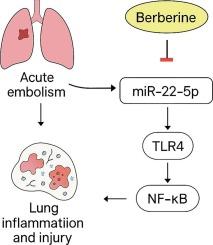Berberine alleviates acute embolism-induced lung inflammation and injury by suppressing miR-22-5p expression and modulating the TLR4/NF-κB signaling pathway
IF 3.4
3区 医学
Q2 PHARMACOLOGY & PHARMACY
引用次数: 0
Abstract
Context
Acute pulmonary embolism (APE) caused by blood clotting in pulmonary arteries triggers lung microvascular leakage and inflammation. While APE significantly affects right ventricular function, the associated lung injury and inflammation mechanisms remain understudied. Berberine has been established as an effective anti-inflammatory compound in traditional medicine.
Objective
To investigate whether berberine can prevent APE-associated inflammation and pulmonary hypertension, potentially facilitating thrombus resolution in pulmonary arteries.
Materials & methods
We employed pulmonary artery smooth muscle cells (PASMCs) treated with platelet-derived growth factor (PDGF) as an in vitro pulmonary embolism model and Sprague-Dawley rats treated with blood clot suspension as an in vivo model. Berberine treatment, miR-22-5p modulation and toll-like receptor (TLR4) overexpression were performed to elucidate the underlying mechanisms.
Results
Berberine treatment attenuated PDGF-induced proliferation of PASMCs in a dose-dependent manner. In the APE model, berberine administration significantly reduced elevated right ventricular systolic pressure (RVSP) and mean pulmonary arterial pressure (mPAP) while alleviating lung inflammation. Berberine treatment downregulated miR-22-5p expression in lung tissue, whereas miR-22-5p overexpression in lungs exacerbated lung inflammation responses. Conversely, miR-22-5p inhibition attenuated lung inflammation and hypertension status. Moreover, miR-22-5p overexpression increased the protein levels of TLR4 and nuclear factor kappa B (NF-κB), whereas miR-22-5p inhibition reduced them. Berberine treatment decreased the levels of miR-22-5p, TLR4, and NF-κB, while TLR4 overexpression reversed the beneficial effects of berberine treatment.
Discussion and conclusion
Our findings suggest that berberine treatment prevents pulmonary hypertension and lung inflammation associated with APE through inhibition of the miR-22-5p/TLR4/NF-κB signaling pathway.

小檗碱通过抑制miR-22-5p表达和调节TLR4/NF-κB信号通路减轻急性栓塞性肺炎症和损伤。
背景:肺动脉凝血引起的急性肺栓塞(APE)引发肺微血管渗漏和炎症。虽然APE显著影响右心室功能,但相关的肺损伤和炎症机制仍未得到充分研究。在传统医学中,小檗碱是一种有效的抗炎化合物。目的:探讨小檗碱是否能预防ape相关炎症和肺动脉高压,并可能促进肺动脉血栓的溶解。材料与方法:采用血小板衍生生长因子(PDGF)处理的肺动脉平滑肌细胞(PASMCs)作为体外肺栓塞模型,血凝块悬浮液处理的Sprague-Dawley大鼠作为体内模型。通过小檗碱治疗、miR-22-5p调节和toll样受体(TLR4)过表达来阐明潜在的机制。结果:小檗碱治疗以剂量依赖的方式减弱pdgf诱导的PASMCs增殖。在APE模型中,给药小檗碱可显著降低升高的右心室收缩压(RVSP)和平均肺动脉压(mPAP),同时减轻肺部炎症。小檗碱治疗下调了肺组织中miR-22-5p的表达,而肺中miR-22-5p的过表达加剧了肺部炎症反应。相反,miR-22-5p抑制可减轻肺部炎症和高血压状态。此外,miR-22-5p过表达增加了TLR4和核因子κB (NF-κB)的蛋白水平,而miR-22-5p抑制则降低了它们的水平。小檗碱治疗降低了miR-22-5p、TLR4和NF-κB的水平,而TLR4过表达逆转了小檗碱治疗的有益作用。讨论和结论:我们的研究结果表明,小檗碱治疗通过抑制miR-22-5p/TLR4/NF-κB信号通路来预防肺动脉高压和与APE相关的肺部炎症。
本文章由计算机程序翻译,如有差异,请以英文原文为准。
求助全文
约1分钟内获得全文
求助全文
来源期刊
CiteScore
6.80
自引率
2.60%
发文量
309
审稿时长
32 days
期刊介绍:
Toxicology and Applied Pharmacology publishes original scientific research of relevance to animals or humans pertaining to the action of chemicals, drugs, or chemically-defined natural products.
Regular articles address mechanistic approaches to physiological, pharmacologic, biochemical, cellular, or molecular understanding of toxicologic/pathologic lesions and to methods used to describe these responses. Safety Science articles address outstanding state-of-the-art preclinical and human translational characterization of drug and chemical safety employing cutting-edge science. Highly significant Regulatory Safety Science articles will also be considered in this category. Papers concerned with alternatives to the use of experimental animals are encouraged.
Short articles report on high impact studies of broad interest to readers of TAAP that would benefit from rapid publication. These articles should contain no more than a combined total of four figures and tables. Authors should include in their cover letter the justification for consideration of their manuscript as a short article.

 求助内容:
求助内容: 应助结果提醒方式:
应助结果提醒方式:


